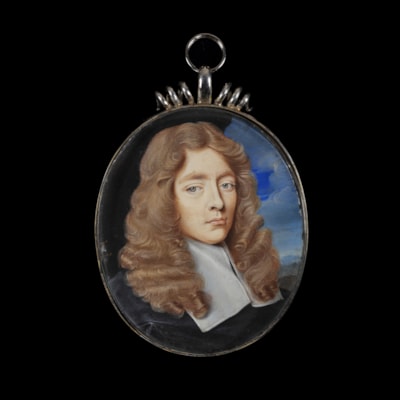ISAAC OLIVER
(c.1565-1617)Portrait miniature of Lady Dorothy Sidney (née Percy) (c.1598-1659), later Countess of Leicester, wearing elaborate embroidered dress, pearl necklace and earring, a garland of fresh flowers in her loose blonde hair
Circa 1615
Watercolour on parchment, laid down on a playing card (two of clubs)
Silver frame with rope-twist border and fleur-de-lys finials
Signed with monogram ‘IO’, the playing card reverse inscribed in a contemporary hand in ink, ‘La: Dorothy/ Percy./ afterwards/ Countesse of/ Leycister’
Oval, 52 mm (2 inches) high
SOLD
A question arises as to why Dorothy seems to have been depicted with flowers so consistently. There are a few possible suggestions to why this is. It is possible that she was simply associated with flowers like these, however, this is quite unlikely given that these portraits were created at different times of her life. Another explanation would be allegorical- that Dorothy is depicted here in the guise of Flora, the Roman goddess of flowers and spring, whose Greek Counterpart is Chloris. Naturally, the iconography of these goddesses usually features flowers, which matches the present miniature. Furthermore, in Roman mythology, Flora was one of the goddesses of fertility, and of youth. This is particularly fitting for our sitter, who, in her short life of 44 years, had twelve children. Another depiction thought to be of Dorothy, by Oliver, was sold in 2013, and depicts her holding a sprig of rosemary, similarly a symbol of love, remembrance, fidelity, and loyalty.
Just why Dorothy would have been depicted as a goddess, however, requires further explanation. Oliver is known to have depicted many sitters ‘costume’ like this, including a portrait of an unknown woman at the V&A, and a young lady in costume at the Rijksmuseum. Both of these sitters are in ‘Masque’ costume. At the Jacobean court, Masque played an important role. Both Queen Anne and King James I had enjoyed participating in these theatrical shows, many of which were designed by renowned architect Inigo Jones. Though no evidence has yet been found to place Dorothy within one of these shows, it is possible that she is being depicted here as part of a wider trend of women being depicted wearing masque dress. Dorothy’s daughter, also Dorothy (and known as Dolly, 1617-1684) had been involved in one of these performances, of Luminalia: The Queen’s Festival of Light, in 1638 , so, this was not something that would have been completely alien to our sitter.
Isaac Oliver, being Queen Anne’s limner, would have at least been aware of, if not involved in, these masques. The miniaturist had trained under Nicholas Hilliard, but in his own work diverted away from the more traditional style that his master had encouraged. This is something that is especially reflected in the present miniature, given the fact that Dorothy wears a relatively low-cut dress and is wearing such a costume. The sitter’s family had been closely connected to both Oliver and his master, Dorothy’s father having been painted in an unusual miniature form, laid on grass, by Hilliard in c.1594-1595, in the Rijksmuseum, Amsterdam . The Essex family were patrons of the artist and Catharine MacLeod has talked about the influence that the artist had on the iconography of the family. Here, it can be seen that this was an influence that carried on into the next generation.
Probably Leicester House (likely the miniature listed in the 1737 inventory made after the death of Probably John Sidney, 6th Earl of Leicester);
Probably Jocelyn Sidney, 7th Earl of Leicester;
Probably William Perry (who married Elizabeth Sidney, niece of John Sidney, 6th Earl of Leicester (1680-1737); Probably by descent until Private Collection, Germany;
Bonhams, New Bond Street, ‘The Albion collection of Fine Portrait Miniatures’, 22 April 2004, lot 4;
Private Collection;
Private Collection, UK.
The World to the Portrait Miniature (exh. cat., Bath, 1999), cat. no.3;
W. Aslet, L. Hendra, R. Ingram, E. Rutherford, Jewel in the Hand: Early Portrait Miniatures from Noble and Private Collections (catalogue for the exhibition at Philip Mould & Co. 12 March – 18 April 2019), cat. No. 18;
E. Rutherford; L. Henrdra (Eds), Philip Mould & Company, London, 2021, Love’s Labour’s Found, cat. 17, ill. P.94.
Bath, Holburne Museum of Art, Secret Passion to Noble Fashion: The World to the Portrait Miniature, 21 April – 18 July 1999, no.3;
Edinburgh, Scottish National Portrait Gallery, 2000-2003;
Philip Mould & Co., Jewel in the Hand: Early Portrait Miniatures from Noble and Private Collections, 12 March – 18 April 2019;
Philip Mould & Co. Love’s Labour’s Found: Elizabethan & Jacobean Portraiture, 21st April – 28th May 2021.

shipping notice
Worldwide shipping is included in all prices.
The Limner Company does not accept any responsibility for import duty, this is to be paid by the buyer.
Some stock items contain materials from endangered species which are governed by CITES regulations and will require a permit to export outside of Great Britain. If a certificate of export is required then this will be the responsibility of and paid for by the buyer .
you may also like













